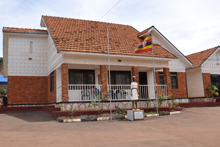
Creating Partnerships in Support of Health Workers in Uganda
 In Uganda, CapacityPlus works in collaboration with the Uganda Capacity Program and key country-level colleagues to strengthen the health workforce. This is an excerpt from an original post on the IntraHealth International blog.
In Uganda, CapacityPlus works in collaboration with the Uganda Capacity Program and key country-level colleagues to strengthen the health workforce. This is an excerpt from an original post on the IntraHealth International blog.
I could begin every blog talking about the many countries, like Uganda, that find it challenging to build and maintain the kind of health workforce needed to deliver high-quality health services, particularly when faced with inadequate funding for human resources for health. These challenges can lead to health worker dissatisfaction, attrition, and absenteeism and are exacerbated by not enough of the right skill sets among health workers or by poor geographic distribution of those skills. But what I want to focus on today is what countries are actually doing to respond to these challenges, employ more staff, improve the workplace, and create strong leadership and management in the health sector.
The Uganda Capacity Program has been collaborating with civil society organizations—including Group for Health Human Rights and HIV/AIDS, Uganda National Health Consumers Organization, Health Global Access Project, and many others—to advocate for more funding to support higher health worker salaries and to hire more health workers in Uganda to provide much-needed health services. By the most recent estimates, Uganda currently has 58,899 health professionals registered with the health professional councils: 31,675 nurses; 13,075 allied health professionals; 10,491 midwives; and 3,658 medical doctors or dentists. It might sound like a lot of health workers, but it is not enough to serve a population of 33 million.
By the most recent estimates, Uganda currently has 58,899 health professionals registered with the health professional councils: 31,675 nurses; 13,075 allied health professionals; 10,491 midwives; and 3,658 medical doctors or dentists. It might sound like a lot of health workers, but it is not enough to serve a population of 33 million.
The Health Sector Strategic and Investment Plan has set the goal of growing the number of health workers to meet at least 65% of the national need, from its current level of 56%. To do this, the country needs about 5,000 additional health workers. Nurses, midwives, and clinical officers are in particularly high demand to care for the overwhelming number of patients in local health facilities in rural areas. The cost of recruiting and paying the salaries of 5,000 new health workers for one year is estimated at about $16.5 million USD or 43 billion Ugandan shillings.
In collaboration with other civil society organizations and the budget officer of Parliament’s budget committee, the Uganda Capacity Program successfully advocated for the reallocation of these funds from other areas of the health sector budget. The civil society organizations have also asked Parliament to allocate additional funds to cover the district recruitment process this year. The advocacy in Parliament is also being reinforced with local work on a district-by-district basis.
Related items:
Photo 1 courtesy of Charles Matsiko. Photo 2 by Carol Bales (Uganda Nurses and Midwives Council).


